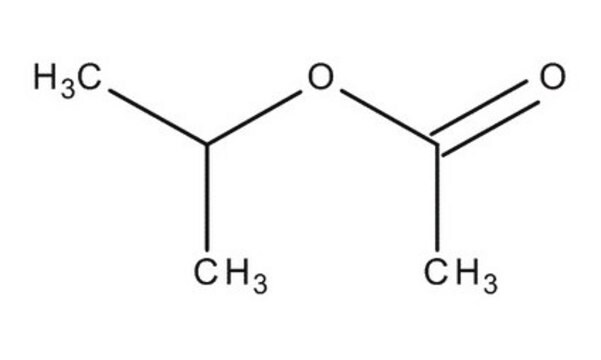Kluczowe dokumenty
W292605
Isopropyl acetate
≥99%, FCC
Synonim(y):
Acetic acid isopropyl ester
Wybierz wielkość
220,00 zł
Wybierz wielkość
About This Item
Halal
Kosher
meets purity specifications of JECFA
220,00 zł
Polecane produkty
pochodzenie biologiczne
synthetic
Poziom jakości
klasa czystości
Fragrance grade
Halal
Kosher
agency
follows IFRA guidelines
meets purity specifications of JECFA
zgodność regionalna
EU Regulation 1223/2009
FCC
FDA 21 CFR 172.515
gęstość pary
3.5 (vs air)
ciśnienie pary
47 mmHg ( 20 °C)
Próba
≥99%
Formularz
liquid
temp. samozapłonu
894 °F
granice wybuchowości
1.8 %, 37 °F
8 %
współczynnik refrakcji
n20/D 1.377 (lit.)
bp
85-91 °C (lit.)
mp
−73 °C (lit.)
gęstość
0.872 g/mL at 25 °C (lit.)
Zastosowanie
flavors and fragrances
Dokumentacja
see Safety & Documentation for available documents
alergen pokarmowy
no known allergens
alergen zapachowy
no known allergens
Organoleptyczne
banana; ethereal; fruity; sweet
ciąg SMILES
CC(C)OC(C)=O
InChI
1S/C5H10O2/c1-4(2)7-5(3)6/h4H,1-3H3
Klucz InChI
JMMWKPVZQRWMSS-UHFFFAOYSA-N
Szukasz podobnych produktów? Odwiedź Przewodnik dotyczący porównywania produktów
Zastosowanie
- Comparative Study on the H-Abstraction Reactions of Isopropyl Acetate and Propyl Acetate by HO(2) and OH Radicals.: This research explores the reactivity of isopropyl acetate with radicals, crucial for understanding its stability and degradation in atmospheric conditions, offering insights relevant to environmental chemistry (Gao et al., 2024).
- Diastereoselective and Scalable Synthesis of 6-(S)-Hydroxycannabidivarin.: This study includes methods where isopropyl acetate is used in the synthesis of cannabinoids, demonstrating its utility in enhancing reaction conditions for pharmaceutical applications (Stone et al., 2023).
- Volatile Dual-Solvent Assisted Intermediate Phase Regulation for Anti-Solvent-Free Perovskite Photovoltaics.: Discusses the use of isopropyl acetate in producing advanced materials for solar cells, emphasizing its role in optimizing fabrication processes and enhancing the efficiency of renewable energy technologies (Yang et al., 2023).
Oświadczenie o zrzeczeniu się odpowiedzialności
Hasło ostrzegawcze
Danger
Zwroty wskazujące rodzaj zagrożenia
Zwroty wskazujące środki ostrożności
Klasyfikacja zagrożeń
Eye Irrit. 2 - Flam. Liq. 2 - STOT SE 3
Organy docelowe
Central nervous system
Zagrożenia dodatkowe
Kod klasy składowania
3 - Flammable liquids
Klasa zagrożenia wodnego (WGK)
WGK 1
Temperatura zapłonu (°F)
41.0 °F - closed cup
Temperatura zapłonu (°C)
5 °C - closed cup
Środki ochrony indywidualnej
Eyeshields, Faceshields, Gloves, type ABEK (EN14387) respirator filter
Wybierz jedną z najnowszych wersji:
Masz już ten produkt?
Dokumenty związane z niedawno zakupionymi produktami zostały zamieszczone w Bibliotece dokumentów.
Klienci oglądali również te produkty
Active Filters
Nasz zespół naukowców ma doświadczenie we wszystkich obszarach badań, w tym w naukach przyrodniczych, materiałoznawstwie, syntezie chemicznej, chromatografii, analityce i wielu innych dziedzinach.
Skontaktuj się z zespołem ds. pomocy technicznej












